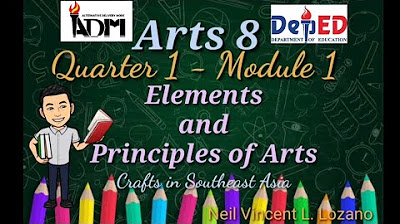(REVISED) ARTS 10 - ABSTRACTIONISM / 20TH CENTURY ART MOVEMENT / QUARTER 1
Summary
TLDRToday's video delves into the 20th-century art movement of abstractionism, highlighting its focus on lines, shapes, colors, and forms over visual reality. It differentiates into representational and pure abstractionism, with the latter avoiding real-world depictions. Key characteristics include an emphasis on formal qualities, vivid colors, shape reconstruction, rejection of realistic perspective, and geometrical elements. The video features notable artists like Picasso, Severini, and Léger, showcasing their influential works in cubism, futurism, and mechanical style.
Takeaways
- 🎨 Abstractionism is an art style that focuses on lines, shapes, colors, and forms rather than visual reality.
- 📅 It emerged in the 20th century as a contrast to the emotional expressionism, emphasizing logic and rationality.
- 🔍 Abstract art is categorized into representational abstractionism, which retains recognizable subjects, and pure abstractionism, which avoids real-world depictions.
- 🎭 The key characteristics of abstractionism include an emphasis on formal qualities, vivid arbitrary colors, reconstructed shapes, rejection of realistic perspective, and the use of geometrical shapes, patterns, lines, angles, and textures.
- 🌀 Abstractionism often involves swirls of colors to create a dynamic visual effect.
- 🖌️ Cubism, a style within abstractionism, is exemplified by Pablo Picasso's works such as 'Girl Before a Mirror' and 'Girl with a Mandolin'.
- 🚀 Futurism, represented by Gino Severini, is characterized by works like 'Memories of a Journey' and 'Dynamic Hieroglyphic of the Bal Tabarin', which depict movement and speed.
- 🏙️ Mechanical Style, as seen in the works of Fernand Léger like 'The City' and 'Contrast of Forms', is another abstractionism style focusing on urban and mechanical elements.
- 🌳 Objectivism, with Piet Mondrian as a key figure, is represented by works such as 'New York City 1' and 'Gray Tree', emphasizing simple geometric forms and primary colors.
- 📺 The video serves as an educational resource, providing an overview of abstractionism and its various styles within the 20th-century art movement.
Q & A
What is abstractionism in art?
-Abstractionism is an art style that communicates through lines, shapes, colors, and forms rather than depicting visual reality. It emerged in the 20th century and emphasizes logic and rationality over emotional expression.
How does abstractionism contrast with expressionism?
-Abstractionism contrasts with expressionism by focusing on logic and rationality instead of emotional content. While expressionism emphasizes the artist's emotions, abstractionism prioritizes the formal qualities of the artwork.
What are the two main divisions of abstract art?
-Abstract art is divided into representational abstractionism, which retains recognizable subjects, and pure abstractionism, which avoids any depiction of real-world objects.
What are the distinct characteristics of abstractionism?
-Distinct characteristics of abstractionism include emphasizing an artwork's formal qualities, using vivid arbitrary colors, reconstructing shapes, rejecting realistic perspective, and utilizing geometrical shapes, patterns, lines, angles, and textures.
What is representational abstractionism?
-Representational abstractionism is a form of abstract art that retains recognizable subjects while still emphasizing the formal qualities of the artwork over realistic depiction.
What is pure abstractionism?
-Pure abstractionism is a form of abstract art that avoids any depiction of real-world objects, focusing solely on the use of colors, shapes, and forms to create a composition.
Which artist is associated with cubism and what are some of their notable works?
-Pablo Ruiz Picasso is associated with cubism. Some of his notable works include 'Girl Before a Mirror' from 1932 and 'Girl with Mandolin' from 1910.
What is futurism and who is a notable artist in this movement?
-Futurism is an early 20th-century art movement that emphasized speed, technology, and objects in motion. Gino Severini is a notable artist in this movement, known for works such as 'Memories of a Journey' from 1911.
What is the mechanical style and which artist is known for it?
-The mechanical style is an art movement characterized by the depiction of mechanical objects and scenes. Fernand Léger is known for this style, with works like 'The City' from 1919 and 'Contrast of Forms' from 1913.
What is objectivism in art, and which artist is associated with it?
-Objectivism is an art movement that focuses on the representation of objects in a simplified and abstract manner. Georges Braque is associated with this movement, with works such as 'New York City 1' from 1942 and 'Gray Tree' from 1911.
How does the use of geometrical shapes and patterns contribute to abstractionism?
-The use of geometrical shapes and patterns in abstractionism contributes to the emphasis on formal qualities and the rejection of realistic perspective. It allows artists to explore form and structure in a non-representational way.
Outlines

Cette section est réservée aux utilisateurs payants. Améliorez votre compte pour accéder à cette section.
Améliorer maintenantMindmap

Cette section est réservée aux utilisateurs payants. Améliorez votre compte pour accéder à cette section.
Améliorer maintenantKeywords

Cette section est réservée aux utilisateurs payants. Améliorez votre compte pour accéder à cette section.
Améliorer maintenantHighlights

Cette section est réservée aux utilisateurs payants. Améliorez votre compte pour accéder à cette section.
Améliorer maintenantTranscripts

Cette section est réservée aux utilisateurs payants. Améliorez votre compte pour accéder à cette section.
Améliorer maintenantVoir Plus de Vidéos Connexes

ARTS 10 / ABSTRACTIONISM / QUARTER 1 / MODULE 2 / 20TH CENTURY ART MOVEMENT

(REVISED) ARTS 10 - EXPRESSIONISM / 20TH CENTURY ART MOVEMENT / QUARTER 1

Arts 8 Quarter 1 Module 1 (Elements of Arts and Principle of Design)

UNSUR UNSUR SENI RUPA | MENGENAL DASAR DASAR SENI RUPA

(REVISED) ARTS 10 - IMPRESSIONISM / 20TH CENTURY ART MOVEMENT / QUARTER 1

Evolution of Art Nouveau
5.0 / 5 (0 votes)
